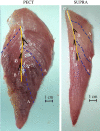Reduction of wing area affects estimated stress in the primary flight muscles of chickens
- PMID: 38034124
- PMCID: PMC10685109
- DOI: 10.1098/rsos.230817
Reduction of wing area affects estimated stress in the primary flight muscles of chickens
Abstract
In flying birds, the pectoralis (PECT) and supracoracoideus (SUPRA) generate most of the power required for flight, while the wing feathers create the aerodynamic forces. However, in domestic laying hens, little is known about the architectural properties of these muscles and the forces the wings produce. As housing space increases for commercial laying hens, understanding these properties is important for assuring safe locomotion. We tested the effects of wing area loss on mass, physiological cross-sectional area (PCSA), and estimated muscle stress (EMS) of the PECT and SUPRA in white-feathered laying hens. Treatments included Unclipped (N = 18), Half-Clipped with primaries removed (N = 18) and Fully-Clipped with the primaries and secondaries removed (N = 18). The mass and PCSA of the PECT and SUPRA did not vary significantly with treatment. Thus, laying hen muscle anatomy may be relatively resistant to changes in external wing morphology. We observed significant differences in EMS among treatments, as Unclipped birds exhibited the greatest EMS. This suggests that intact wings provide the greatest stimulus of external force for the primary flight muscles.
Keywords: estimated muscle stress; feather loss; keel bone; laying hen; physiological cross-sectional area.
© 2023 The Authors.
Conflict of interest statement
We have no competing interests.
Figures



References
-
- Underwood WJ, McGlone JJ, Swanson J, Anderson KA, Anthony R. 2013. Agricultural animal welfare. In Laboratory animal welfare (eds Bayne K, Turner PV), pp. 233-278. London, UK: Elsevier. (10.10.1016/B978-0-12-385103-1.00015-4. - DOI
Associated data
LinkOut - more resources
Full Text Sources
Research Materials
